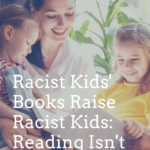This is a pretty common sentiment, especially when it comes to children’s choice of books. In one sense, I completely agree. Kids should be encouraged to find a love of reading, and whether that means picking up comics, classics, books below reading level, books above reading level, or Guinness World Records books, the important part is that they find books that they enjoy reading. That helps to create a lifelong positive association with books. Where this argument does not work, though, is when it is applied to racist, sexist, or otherwise prejudiced or stereotypical representation in books. We book lovers extol the virtues of reading, one of which is that it helps to develop empathy. This is definitely an important thing to teach to children: the ability to put yourself in another person’s shoes, to imagine people complexly, and to treat others the way they would like to be treated. If we are claiming that children learn empathy for others from books, though, we can’t also claim that it doesn’t matter what they’re reading. This post was inspired by Ellen Oh’s excellent thread about racism in kid lit and YA (check it out for examples). I reached out to her about writing this post, and she wanted to make clear that she isn’t looking for censorship, but is “asking for a discussion of how these books perpetuate racist stereotypes that do actual real life harm.” So often, we hear, “books teach empathy!” and “let them read anything as long as they’re reading,” and the thing is that some books are really racist or homophobic and those books teach racism and homophobia. Books are only as empathetic as the people who made them. — Ishta Mercurio 🏳️🌈 (@IshtaWrites) April 4, 2021 Books are a tool for empathy because they allow us to be inside another person’s head, to see the world through their eyes. By reading about lots of different people, we learn how others see the world, and we (hopefully) become sympathetic to other points of view. There is an important piece here, though: we need to be reading about a diversity of experiences, and those experiences have to be authentic. If we immerse ourselves in a fictional point of view, and that character is a stereotype, we can also absorb that stereotype as a fact of life. This means that it’s important to choose carefully which books kids are exposed to. While many people’s knee-jerk reaction is to be appalled at the idea that I’m cancelling Seuss (or whoever), this is less about limitations and more about additions. The standard American diet of children’s lit is suffocatingly homogenous. Most people, when choosing which books to buy for a kid in their life, will choose the same books that they read. Likely, those were the same ones their parents read. This means that the same books, almost always by white authors depicting white cis het abled characters, become the foundation of children’s reading throughout time. The problem with the racism in Seuss books and titles like it is two-fold: one is, of course, that exposing children to racist imagery and stereotypes can result in them internalizing them; the other is that for many kids, these racist depictions may be the only representations they’ve seen of Asian characters or Black characters, or one of a small handful. The fewer depictions of a kind of person that a kid sees, the more weight is placed on each individual one. A kid who has read a wide range of Indigenous-authored book will likely read Little House on the Prairie and show skepticism of the depiction of Indigenous people there. But for a kid who hasn’t read any books with Indigenous main characters — which is common, considering about 1.6% of kids’ books have Indigenous main characters — that portrayal might play an important role in how they picture Indigenous people. This doesn’t mean that you can’t read problematic books with kids. Nashae Jones at HuffPost wrote a great piece about this called, “I’m A Black Mother And Educator. Here’s Why I Let My Kids Read Racist Books.” In it, she discusses reading these books together with her kids, stopping to discuss, and then pairing it with an own voices book. This is a great way to get kids thinking critically about what they’re reading, which is also an incredibly useful skill. The important part is that this has to be collaborative: you can’t assume kids will figure it out on their own. If you’re going to give kids racist (or sexist, ableist, homophobic, transphobic, etc.) books to read, you need to discuss it with them and also make sure they have access to positive depictions of these groups by own voices authors. Encouraging kids to read is a good thing, but not all books are made equal. As long as we accept that books teach empathy, we have to also recognize that they can teach prejudice. The books we read as kids are often the most important, life-altering reads we will ever pick up. They can become a part of our identities and help shape our worldview. With that kind of influence, we should be selecting them mindfully. If you want to find more diverse children’s books, try:
50 Children’s Books About Diversity that Celebrate Our Differences Children’s Books that Center a Disabled Character But Not Their Disability Indigenous Voices for Little Ears: 15 Books About Native American Tradition and History for Children












